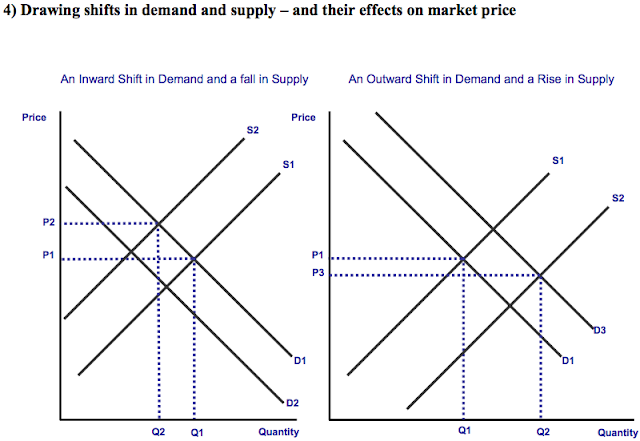Balance Of Payments: Exports minus Imports- a deficit means that there are more imports than exports. A surplus means that there are more exports than imports.
Balance Of Trade: Visible Exports minus Visible Imports
Visible: Exports or Imports that are tangible, that you can see and touch as they cross international boundaries (goods, not services)
Balanced Budget: where government receipts equal government spending in a financial year
Buffer Stock: an intervention system that aims to limit the fluctuation of prices within an economy.
Capital Spending: government spending to improve the productive capacity of a nation, including infrastructure, schools and hospitals.
Cost Push Inflation: an increase in the cost to produce a good or service results in an increase in the cost of sale and then a knock on effect of an increase in the general price level.
Credit Crunch: where borrowing becomes more expensive or unavailable.
Total Planned Expenditure in the economy (C+I+G+X-M)
Economics
Monday, 25 February 2013
Buffer Stocks
A Buffer Stock is an intervention system that aims to limit the fluctuations of the price of a commodity.
Governments may try and intervene in markets which suffer high volatility in the free market prices.
Agricultural and Commodity markets are notorious for having highly volatile prices due to the unpredictable weather, which they are relying upon to grow their goods and relatively inelastic supply and demand curves.
This unpredictability of prices also leads to an unpredictability in incomes for the workers.
LEDC's are particularly hit badly by this as the farmers etc. are already on low wages and sell their goods to foreign powers for very low prices. Thus, if there is a bad harvest, or terrible weather, then they could face extreme poverty and even starvation.
In a stable economy, the government will select an equilibrium price, with which the economy has performed at when things within the economy are good, e.g. inflation low, economic growth growing stably. They will then set a maximum and Minimum Price. This is useful, as it means that if the harvest is poor, then the farmers will still get paid a certain amount for their produce, but also if inflation is high within a country, the firm, and consumers will not have to pay much as a result of the maximum price.
Governments may try and intervene in markets which suffer high volatility in the free market prices.
Agricultural and Commodity markets are notorious for having highly volatile prices due to the unpredictable weather, which they are relying upon to grow their goods and relatively inelastic supply and demand curves.
This unpredictability of prices also leads to an unpredictability in incomes for the workers.
LEDC's are particularly hit badly by this as the farmers etc. are already on low wages and sell their goods to foreign powers for very low prices. Thus, if there is a bad harvest, or terrible weather, then they could face extreme poverty and even starvation.
In a stable economy, the government will select an equilibrium price, with which the economy has performed at when things within the economy are good, e.g. inflation low, economic growth growing stably. They will then set a maximum and Minimum Price. This is useful, as it means that if the harvest is poor, then the farmers will still get paid a certain amount for their produce, but also if inflation is high within a country, the firm, and consumers will not have to pay much as a result of the maximum price.
A Maximum Price is a price ceiling within a market that suppliers cannot exceed in an attempt to prevent the market price from rising above a certain level. To be effective, the maximum price has to be set below the free market price. An example of this is when there is a poor harvest in essential foodstuffs. The usual market response would be to jack up prices due to large amounts of demand but minimal amounts of supply, however, the maximum price means that the poorer or the consumers are not punished.
A minimum price is a price floor below which the normal market price cannot fall. To be effective, the minimum price has to be set below the normal equilibrium price. An example of this is the national Minimum wage, which was introduced into the UK in 1999. It is a price intervention embedded in the labour market to improve the pay and living conditions of the lower income members of society.
Subscribe to:
Posts (Atom)







